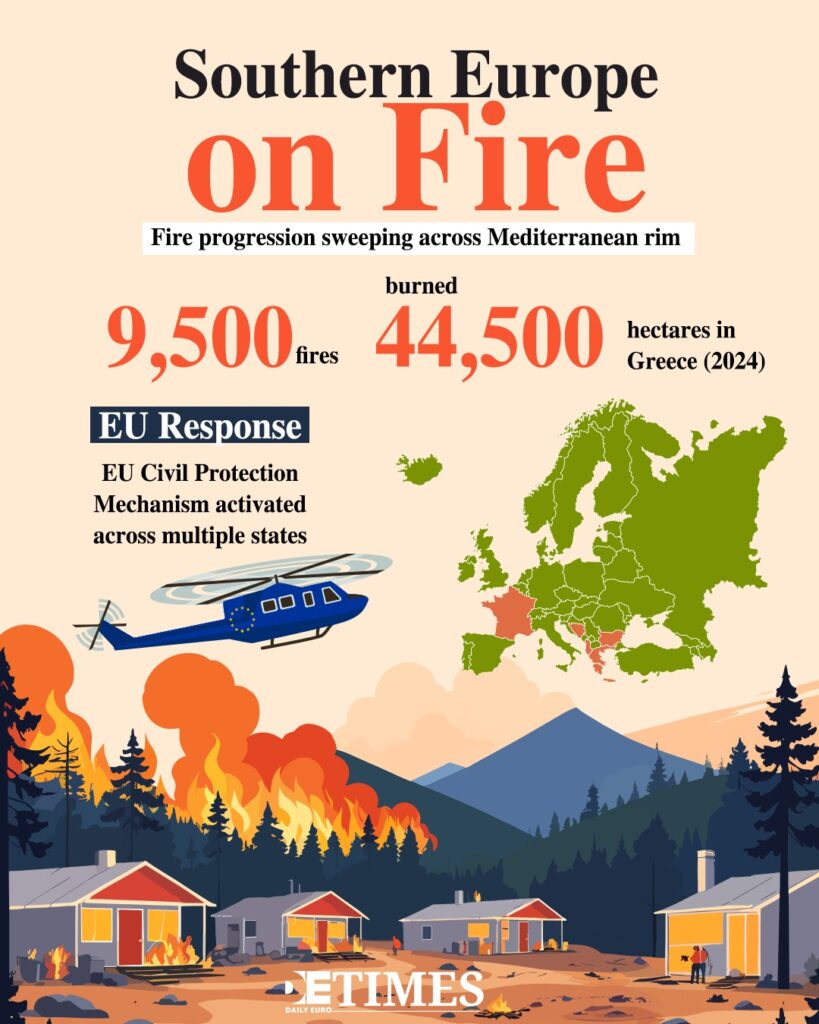The European Union had to activate the Civil Protection Mechanism to battle forest fires roaring across Greece, Spain, Bulgaria, Montenegro, and Albania.
At the same time, France’s Gravelines nuclear power plant shut down because too many jellyfish clogged its water intake, a side effect of rising sea temperatures.
The Mediterranean region is suffering on several fronts, and climate change seems to be pulling Europe apart in ways more concrete than borders or economies.
Southern Europe Faces Rising Wildfire Risk as Climate Changes
Europe’s southern lands have grown hotter and drier during summers over the past decades, turning once fertile forested areas into tinderboxes ready for wildfires. The Civil Protection Mechanism’s activation reflects the scale of this summer’s worst outbreaks.
Each fire not only destroys ecosystems and homes but also disrupts local economies that rely heavily on agriculture and tourism. In northern parts, cooler conditions persist, with milder summers sparing them from the same intensity of heatwaves or blazes. The difference is no longer subtle.
Mediterranean Climate Crisis Threatens Regional Economic Balance
More often than before, southern Europe confronts a future that seems to edge towards desertification.
The Mediterranean’s climate figures have been shifting steadily upwards. Fires extend the wildfire season and cause repeated disruptions, pushing vulnerable communities and national economies into repeated recovery cycles.
Meanwhile, northern Europe’s cooler forests, and greener growth, suffer less. The economic cost and loss of livelihoods deepen regional imbalances within what is supposed to be a unified economic area.
Climate Change Creates New North-South Economic Divide in Europe
Looking closely, one can see how southern Europe bears the brunt of climate risks no other European part matches.
The southern forests dry out faster, making fires harder to control. The economic consequences deepen over time. For instance, farming and forestry shrink under harsher weather, while fire recovery demands expensive manpower and equipment.
Consequent migration from affected zones to northern cities becomes more likely, shifting population and wealth upwards. The EU’s collective prosperity may fray along this very divide.
EU Emergency Response vs Long-Term Climate Solutions
Some contend that the EU’s funds and cooperation efforts will resolve these tensions conveniently.
They highlight the Civil Protection Mechanism as proof that the Union can step in swiftly to mitigate crises. True, the mechanism coordinates firefighting resources across borders, yet it deals with emergencies rather than underlying causes.
Fighting flames year after year, although vital, resembles mopping a floor without fixing the leak beneath. Repeated EU responses might bandage the wounds but leave deeper cracks untouched.
Instead, a firmer grasp on the larger climate challenge is necessary, which goes beyond emergency reactions.
Building Climate Resilience Across European Regions
Safeguarding southern Europe’s natural landscapes calls for sustainable land management and revised agricultural practices that align with hotter, drier conditions. It requires innovative regional development policies that prepare economies for the new climate realities instead of clinging to past models.
Engaging Mediterranean neighbours in shared climate resilience serves everyone. Through partnerships rather than top-down directives, the whole region can withstand the rising heat and shifting weather.

Future of European Union in a Climate-Changed World
If the southern half steadily shifts towards desert-like conditions, its economic output will shrink relative to northern Europe. That shift risks turning the Union into two Europes, divided by climate fate as much as geography.
Climate, a natural force, would redraw economic maps more profoundly than political treaties. This gap demands a thoughtful approach, recognising the natural consequences and adjusting policies accordingly.
Real World Climate Impacts Across European Economies
For instance, Spain’s struggle with ever-growing wildfires disrupts its olive oil exports and rural incomes. Greece experiences repeated setbacks, with around 9,500 fires burning nearly 44,500 hectares in 2024 alone.
Factories in France, although distant, are interrupted when changing seas bring jellyfish masses that cripple nuclear plants. Together, these examples show how climate’s ripple effects cross sectors and borders alike.
Europe’s Climate Challenge: The Critical Decade Ahead
The European Union may well face a critical decade in managing the widening climate gap within its own borders.
Scientists warn that Europe is the world’s fastest warming continent and that as the climate crisis escalates, wildfires will become more frequent and severe. Effectively addressing wildfire risks and changing coastal ecosystems will test the Union’s resolve to find fairness in a hard new reality.
Keep up with Daily Euro Times for more updates!
Read also:
Neocolonialism in the Twenty-First Century, EU Climate Policy
Tourists Under Fire: Europe’s North-South Economic Divide Alight
Fighting Over Thin Air: Europe’s Green Energy Myth






